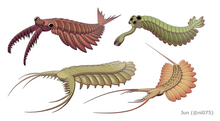| Dinocaridida Temporal range:
| |
|---|---|

| |
| Assembly of dinocaridids (Anomalocaris, Opabinia, Pambdelurion and Kerygmachela) | |
| Scientific classification | |
| Domain: | Eukaryota |
| Kingdom: | Animalia |
| Phylum: | Arthropoda |
| Stem group: | †Dinocaridida Collins, 1996 |
| Subgroups | |
Dinocaridida[derivation 1] is a proposed fossil taxon of basal arthropods,[3] which flourished during the Cambrian period and survived up to Early Devonian. Characterized by a pair of frontal appendages and series of body flaps, the name of Dinocaridids (Greek for deinos "terrible" and Latin for caris "crab") refers to the suggested role of some of these members as the largest marine predators of their time.[3] Dinocaridids are occasionally referred to as the 'AOPK group' by some literatures,[4][5][6] as the group compose of Radiodonta (Anomalocaris and relatives), Opabiniidae (Opabinia and relatives), and the "gilled lobopodians" Pambdelurion and Kerygmachelidae.[7] It is most likely paraphyletic, with Kerygmachelidae and Pambdelurion more basal than the clade compose of Opabiniidae, Radiodonta and other arthropods.[4][8][9]
- ^ Li, Wei; Yang, Jie; Yang, Xiaoyu; Dhungana, Alavya; Wang, Yu; Zhang, Xiguang; Smith, Martin R. (November 2024). "Omnidens appendages and the origin of radiodont mouthparts". Papers in Palaeontology. 10 (6). doi:10.1002/spp2.1600.
- ^ Smith, Martin R.; Long, Emma J.; Dhungana, Alavya; Dobson, Katherine J.; Yang, Jie; Zhang, Xiguang (31 July 2024). "Organ systems of a Cambrian euarthropod larva". Nature. 633 (8028): 120–126. Bibcode:2024Natur.633..120S. doi:10.1038/s41586-024-07756-8. ISSN 1476-4687. PMC 11374701. PMID 39085610.
- ^ a b Collins, D. (1996). "The "Evolution" of Anomalocaris and Its Classification in the Arthropod Class Dinocarida (nov.) and Order Radiodonta (nov.)". Journal of Paleontology. 70 (2): 280–293. Bibcode:1996JPal...70..280C. doi:10.1017/S0022336000023362. JSTOR 1306391. S2CID 131622496.
- ^ a b Budd, Graham E. (1998). "The morphology and phylogenetic significance of Kerygmachela kierkegaardi Budd (Buen Formation, Lower Cambrian, N Greenland)". Earth and Environmental Science Transactions of the Royal Society of Edinburgh. 89 (4): 249–290. doi:10.1017/S0263593300002418. ISSN 1473-7116. S2CID 85645934.
- ^ Liu, Jianni (2004). "A rare lobopod with well-preserved eyes from Chengjiang Lagerstätte and its implications for origin of arthropods". Chinese Science Bulletin. 49 (10): 1063. Bibcode:2004ChSBu..49.1063L. doi:10.1360/04wd0052. ISSN 1001-6538.
- ^ "Morpho-anatomy of the lobopod Magadictyon cf. haikouensis from the Early Cambrian Chengjiang Lagerstätte, South China". Acta Zoologica. 89 (2): 183. 2008. doi:10.1111/j.1463-6395.2007.00307.x. ISSN 1463-6395.
- ^ Cite error: The named reference
:1was invoked but never defined (see the help page). - ^ Cite error: The named reference
:0was invoked but never defined (see the help page). - ^ Cite error: The named reference
:5was invoked but never defined (see the help page).
Cite error: There are <ref group=derivation> tags on this page, but the references will not show without a {{reflist|group=derivation}} template (see the help page).